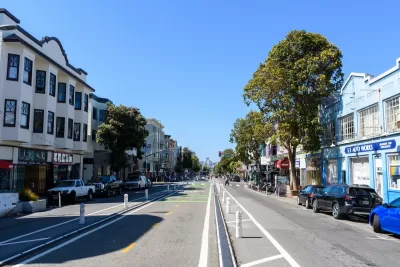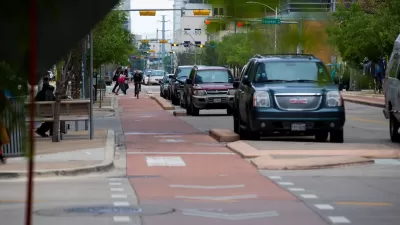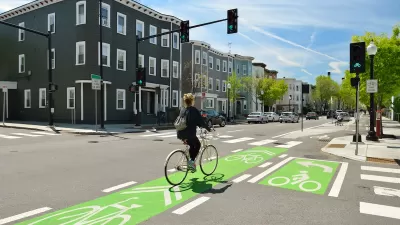A local bike safety protest has become a global phenomenon.

A road safety protest dubbed People Protected Bike Lanes (PPBL) is helping spur action and improve road safety in San Francisco and far beyond, writes Roger Rudick in Streetsblog San Francisco.
The movement, which started in 2017, involves demonstrations “in which participants stand on the street in a line between cyclists and car traffic to demonstrate the inadequacy of existing bicycle infrastructure.”
According to a study from NYU researcher Marcel Moran, “At the close of 2023, 32 of the 55 locations (58 percent) where PPBL took place have had protected bike lanes installed.” Moran attributes the protests’ success in part to their non-combative nature. “They instantly convey what the demonstration is asking for, they show bravery on the part of the participants, but they don't actually delay anybody except perhaps the minority of drivers who were attempting to park illegally on the block, he explained.”
Moran adds, “PPBL represents one of the latest forms of bicycle demonstrations, joining a long history of activism that stretches back decades in both Europe and the United States. For example, Amsterdam’s transition to one of the world’s most bike-friendly cities, including expansive bicycle infrastructure and restrictions on cars, was significantly influenced by consistent protests.”
FULL STORY: Study: People Protected Bike Lanes Made a Difference

Alabama: Trump Terminates Settlements for Black Communities Harmed By Raw Sewage
Trump deemed the landmark civil rights agreement “illegal DEI and environmental justice policy.”

Planetizen Federal Action Tracker
A weekly monitor of how Trump’s orders and actions are impacting planners and planning in America.

The 120 Year Old Tiny Home Villages That Sheltered San Francisco’s Earthquake Refugees
More than a century ago, San Francisco mobilized to house thousands of residents displaced by the 1906 earthquake. Could their strategy offer a model for the present?

LA’s Tree Emergency Goes Beyond Vandalism
After a vandal destroyed dozens of downtown LA trees, Mayor Karen Bass vowed to replace them. Days later, she slashed the city’s tree budget.

Sacramento Leads Nation With Bus-Mounted Bike Lane Enforcement Cameras
The city is the first to use its bus-mounted traffic enforcement system to cite drivers who park or drive in bike lanes.

Seattle Voters Approve Social Housing Referendum
Voters approved a corporate tax to fund the city’s housing authority despite an opposition campaign funded by Amazon and Microsoft.
Urban Design for Planners 1: Software Tools
This six-course series explores essential urban design concepts using open source software and equips planners with the tools they need to participate fully in the urban design process.
Planning for Universal Design
Learn the tools for implementing Universal Design in planning regulations.
Ada County Highway District
Clanton & Associates, Inc.
Jessamine County Fiscal Court
Institute for Housing and Urban Development Studies (IHS)
City of Grandview
Harvard GSD Executive Education
Toledo-Lucas County Plan Commissions
Salt Lake City
NYU Wagner Graduate School of Public Service





























